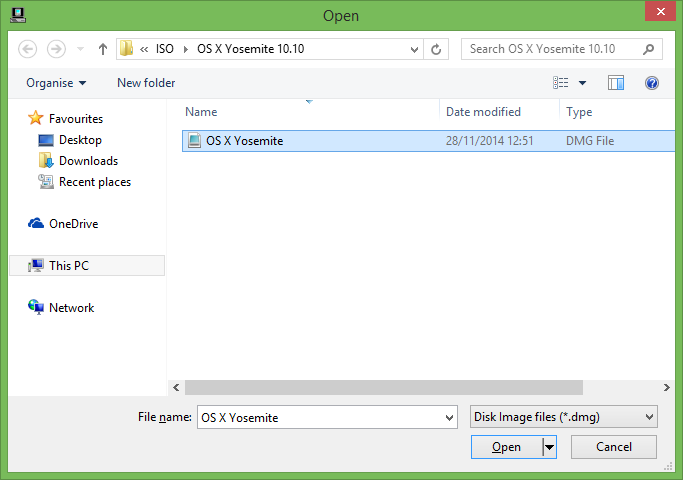- Open Dmg From Recovery Booth
- Open Dmg From Recovery Boot Windows 7
- Open Dmg From Recovery Boot Windows 10
- Open Dmg From Recovery Boot Camp
Open DMG Files with 7-Zip. 7-Zip is a lightweight, but powerful compression tool that is free to download. In addition to extracting DMG files, you can use 7-Zip to extract most types of compressed files out there, including ZIP, CAB, ISO, RAR, and WIM, to name just few. If your Mac does boot into macOS then you can at least check Terminal to see if you have a recovery partition, here's how to do that: Open Terminal. Enter diskutil list. But Recovery Mode does not have the same applications directory access, nor does it have Spotlight or Launchpad. Nonetheless, accessing Terminal from Recovery boot mode is easy. Accessing the Command Line in Recovery Mode on a Mac. Boot into Mac OS Recovery Mode as usual by holding down the Command and R keys during system start. In the Finder, open the Recovery HD drive and then open the com.apple.recovery.boot folder, and you should now see a file called 'BaseSystem.dmg.' Drag this to the list of disks in Disk Utility so. Reset your PC from the sign-in screen. If you can't open Settings, you can reset your PC from the sign-in screen. Here’s how: Press Windows logo key + L to get to the sign-in screen, and then restart your PC by pressing the Shift key while you select the Power button Restart in the lower-right corner of the screen.

These key combinations apply only to Mac computers with an Intel processor, not Mac computers with Apple silicon.
To use any of these key combinations, press and hold the keys immediately after pressing the power button to turn on your Mac, or after your Mac begins to restart. Keep holding until the described behavior occurs.
- Command (⌘)-R: Start up from the built-in macOS Recovery system. Or use Option-Command-R or Shift-Option-Command-R to start up from macOS Recovery over the Internet. macOS Recovery installs different versions of macOS, depending on the key combination you use while starting up. If your Mac is using a firmware password, you're prompted to enter the password.
- Option (⌥) or Alt: Start up to Startup Manager, which allows you to choose other available startup disks or volumes. If your Mac is using a firmware password, you're prompted to enter the password.
- Option-Command-P-R:Reset NVRAM or PRAM. If your Mac is using a firmware password, it ignores this key combination or starts up from macOS Recovery.
- Shift (⇧): Start up in safe mode. Disabled when using a firmware password.
- D: Start up to the Apple Diagnostics utility. Or use Option-Dto start up to this utility over the Internet. Disabled when using a firmware password.
- N: Start up from a NetBoot server, if your Mac supports network startup volumes. To use the default boot image on the server, hold down Option-N instead. Disabled when using a firmware password.
- Command-S: Start up in single-user mode. Disabled in macOS Mojave or later, or when using a firmware password.
- T: Start up in target disk mode. Disabled when using a firmware password.
- Command-V: Start up in verbose mode. Disabled when using a firmware password.
- Eject (⏏) or F12 or mouse button or trackpad button: Eject removable media, such as an optical disc. Disabled when using a firmware password.
Open Dmg From Recovery Booth
If a key combination doesn't work

If a key combination doesn't work at startup, one of these solutions might help:
Open Dmg From Recovery Boot Windows 7

- Press and hold all keys in the combination together, not one at a time.
- Shut down your Mac. Then press the power button to turn on your Mac. Then press and hold the keys as your Mac starts up.
- Wait a few seconds before pressing the keys, to give your Mac more time to recognize the keyboard as it starts up. Some keyboards have a light that flashes briefly at startup, indicating that the keyboard is recognized and ready for use.
- If you're using a wireless keyboard, plug it into your Mac, if possible. Or use your built-in keyboard or a wired keyboard. If you're using a keyboard made for a PC, such as a keyboard with a Windows logo, try a keyboard made for Mac.
- If you're using Boot Camp to start up from Microsoft Windows, set Startup Disk preferences to start up from macOS instead. Then shut down or restart and try again.
Open Dmg From Recovery Boot Windows 10
Remember that some key combinations are disabled when your Mac is using a firmware password.

Learn more
Open Dmg From Recovery Boot Camp
- Keyboard shortcuts that you can use after your Mac has started up.